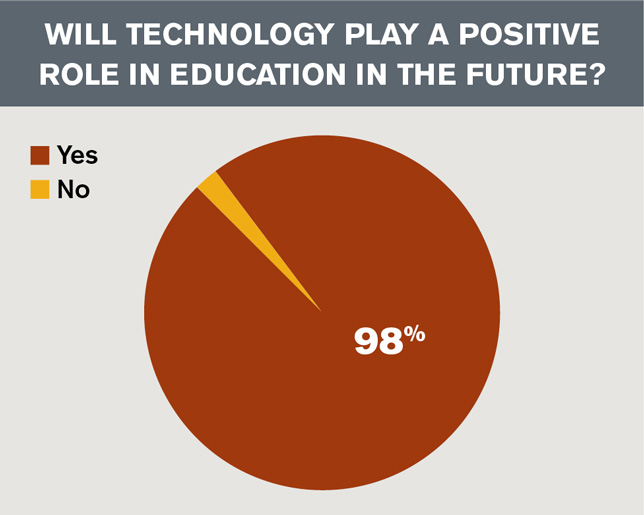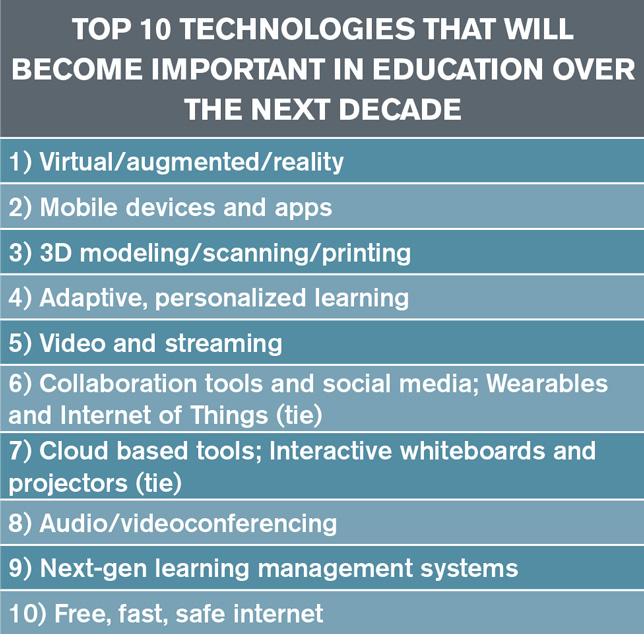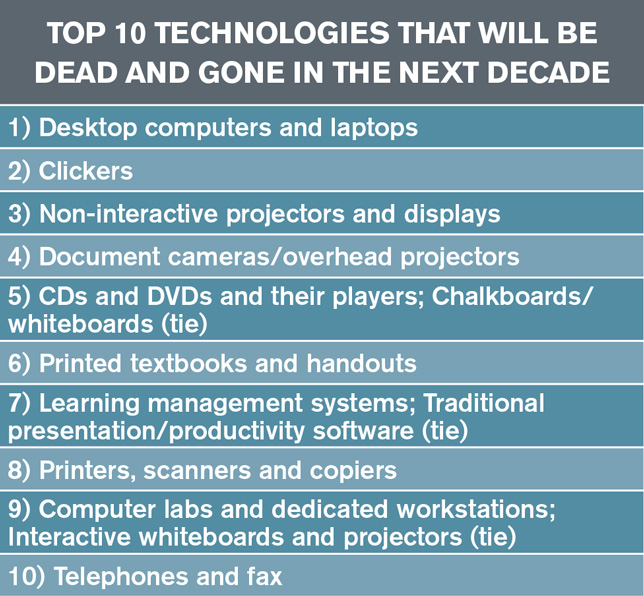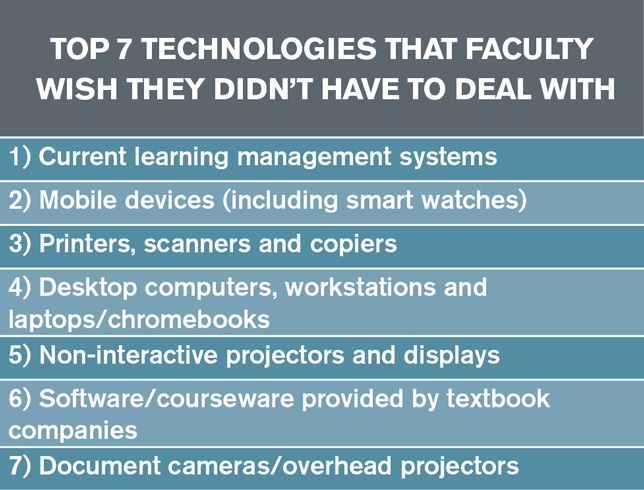Kelly, B. R., & 10/11/17. (n.d.). Faculty Predict Virtual/Augmented/Mixed Reality Will Be Key to Ed Tech in 10 Years -. Retrieved October 31, 2018, from https://campustechnology.com/articles/2017/10/11/faculty-predict-virtual-augmented-mixed-reality-will-be-key-to-ed-tech-in-10-years.aspx




Our survey polled 232 faculty members across the country about their use of technology in the classroom, their likes and dislikes, their predictions for the future and more. The majority of respondents (68 percent) come from public institutions, with 28 percent from private nonprofits and 4 percent working at for-profit schools. Seventy-two percent work at four-year colleges or universities; 26 percent are at community colleges (the remaining 2 percent designated their institutional level as “other”).
Respondents represent institutions of a range of sizes, with about one-third (32 percent) working in colleges or universities with 2,500 to 9,999 students. Just under half (45 percent) of respondents are from institutions with 10,000 students or more.
Our respondents are veterans of higher education: The largest group (47 percent) has more than 20 years of experience, with 81 percent logging at least 11 years in the field.
The top three most common school and college types among our respondents are education (22 percent), business/business administration (17 percent) and liberal arts (12 percent). But overall, respondents work in a wide range of disciplines, from engineering and medicine to humanities and fine arts. The top 10 states with the most survey respondents are New York, Texas, California, Florida, Georgia, Virginia, Illinois, Missouri, Pennsylvania and Massachusetts.
++++++++++++++++
More about XR in this IMS blog:
Emerging Directions in Immersive Learning
Presented by: Maya Georgieva and Emory Craig, May 17, 1:00 – 2:00pm (EDT)
http://events.shindig.com/event/campus-tech
Digital Bodies cofounders Emory Craig and Maya Georgieva for an interactive session that will examine five developments in virtual, augmented, and mixed reality with the greatest potential to impact teaching and learning. Ask your questions live as they explore how groundbreaking developments in VR, AR, MR, and artificial intelligence will power immersive technologies and transform learning.
Hololense $3000 and it is difficult to use outside. persistent digital objects
https://mixed.reality.news/news/whats-difference-between-hololens-meta-magic-leap-0171361/
https://events.google.com/io/
https://unity3d.com/sundance2017
education: new media, gaming
storytelling: immersive storytelling and AI
Jeremy Bailenson https://vhil.stanford.edu/
Julie Johnston – https://uits.iu.edu/learning-spaces
11 Ed Tech Trends to Watch in 2017
Five higher ed leaders analyze the hottest trends in education technology this year.
http://pdf.101com.com/CampusTech/2017/701921020/CAM_1702DG.pdf
new forms of human-computer interaction (HCI) such as augmented reality (AR),virtual reality (VR) and mixed reality (MR).
p. 21
combining AR/VR/MR with cognitive computing and artificial intelligence (AI) technologies (such as machine learning, deep learning, natural language processing and chatbots).
Some thought-provoking questions include:
- Will remote workers be able to be seen and interacted with via their holograms (i.e., attending their meetings virtually)? What would this mean for remote learners?
- Will our smartphones increasingly allow us to see information overlaid on the real world? (Think Pokémon Go, but putting that sort of technology into a vast array of different applications, many of which could be educational in nature)
- How do/will these new forms of HCI impact how we design our learning spaces?
- Will students be able to pick their preferred learning setting (i.e., studying by a brook or stream or in a virtual Starbucks-like atmosphere)?
- Will more devices/platforms be developed that combine the power of AI with VR/AR/MR-related experiences? For example, will students be able to issue a verbal question or command to be able to see and experience walking around ancient Rome?
- Will there be many new types of learning experiences,like what Microsoft was able to achieve in its collaboration with Case Western Reserve University [OH]? Its HoloLens product transforms the way human anatomy can be taught.
p. 22 Extensive costs for VR design and development drive the need for collaborative efforts.
Case Western Reserve University, demonstrates a collaboration with the Cleveland Clinic and Microsoft to create active multi-dimensional learning using holography.
the development of more affordable high-quality virtual reality solutions.
AR game developed by the Salzburg University of Applied Sciences [Austria] (
http://www.fh-salzburg.ac.at/en/) that teaches about sustainability, the environment and living green.
Whether using AR for a gamified course or to acclimate new students to campus, the trend will continue into 2017.
++++++++++++++++++++++++++++++
15 Tech Tool Favorites From ISTE 2016
list of resources that can help educators find what they need
Google Expeditions
This virtual reality field trip tool works in conjunction with Google Cardboard and has just been officially released. The app allows teachers to guide students through an exploration of 200 (and growing) historical sites and natural resources in an immersive, three-dimensional experience. The app only works on Android devices and is free.
Flippity
This app works in conjunction with Google Sheets and allows teachers to easily make a Jeopardy-style game.
Google Science Journal
This Android app allows users to do science experiments with mobile phones. Students can use sensors in the phone or connect external sensors to collect data, but can also take notes on observations, analyze and annotate within the app.
Google Cast
This simple app solves issues of disparate devices in the classroom. When students download the app, they can project from their devices onto the screen at the front of the room easily. “You don’t have to have specific hardware, you just have to have Wi-Fi,”
Constitute
This site hosts a database of constitutions from around the world. Anything digitally available has been aggregated here. It is searchable by topic and will pull out specific excerpts related to search terms like “freedom of speech.”
YouTube
a database of YouTube Channels by subject to help educators with discoverability (hint subjects are by tab along the bottom of the document).
Zygote Body
This freemium tool has a lot of functionality in the free version, allowing students to view different parts of human anatomy and dig into how various body systems work.
Pixlr
This app has less power than Photoshop, but is free and fairly sophisticated. It works directly with Google accounts, so students can store files there.
uild With Chrome
This extension to the Chrome browser lets kids play with digital blocks like Legos. Based on the computer’s IP address, the software assigns users a plot of land on which to build nearby. There’s a Build Academy to learn how to use the various tools within the program, but then students can make whatever they want.
Google CS First
Built on Scratch’s programming language, this easy tool gives step-by-step instructions to get started and is great for the hesitant teacher who is just beginning to dip a toe into coding.
+++++++++++++++
More on VR in this IMS bloghttps://blog.stcloudstate.edu/ims?s=virtual+reality



